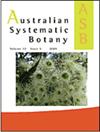An integrative taxonomic approach resolves the Prostanthera lasianthos (Lamiaceae) species complex
IF 1.5
3区 生物学
Q4 EVOLUTIONARY BIOLOGY
引用次数: 3
Abstract
Abstract. The diagnostic characteristics and distinctiveness of plant taxa have traditionally been based on a combination of geographic and morphological discontinuity. Implicit within these concepts is the notion that morphological variation is fixed and that gene flow among taxa is limited. However, species complexes that comprise a range of more-or-less continuous morphotypes often confound such assumptions and resist formal taxonomic treatment. A range of independent data sources, namely, nucleotide sequences, volatile oils and traditional morphology, were used in an integrative approach to resolve the taxonomic structure within the geographically widespread species complex of Prostanthera lasianthos Labill. We concluded that no dataset has primacy in defining segregate taxa, and that a combination of morphological and molecular data was required to determine the taxa within. As a result, we amended the description of P. lasianthos sens. strict. and recognise the following five new segregate species: Prostanthera largiflorens B.J.Conn & K.Proft, P. lasiangustata J.Carrick ex B.J.Conn & K.Proft, P. rupicola B.J.Conn & K.Proft, P. subalpina B.J.Conn & K.Proft, and P. williamsii B.J.Conn & K.Proft.一种综合分类学方法解决了原stanthera lasianthos (Lamiaceae)物种复合体
摘要植物分类群的诊断特征和独特性传统上是基于地理和形态不连续性的结合。这些概念中隐含的概念是形态变异是固定的,分类群之间的基因流动是有限的。然而,由一系列或多或少连续形态组成的物种复合体往往会混淆这些假设,并抵制正式的分类处理。利用核苷酸序列、挥发油和传统形态学等独立数据源,对分布广泛的lasianthos Prostanthera lasianthos Labill物种复合体的分类结构进行了综合分析。我们认为,没有一个数据集在确定隔离分类群方面具有优势,需要结合形态学和分子数据来确定隔离分类群。因此,我们修改了P. lasianthos sens. strict的描述。并发现以下5个新的分离种:Prostanthera largiflorens B.J.Conn & k.k proft, P. lasiangustata J.Carrick ex B.J.Conn & k.k proft, P. rupicola B.J.Conn & k.k proft, P. subalpina B.J.Conn & k.k proft, P. williamsii B.J.Conn & k.k proft。
本文章由计算机程序翻译,如有差异,请以英文原文为准。
求助全文
约1分钟内获得全文
求助全文
来源期刊

Australian Systematic Botany
生物-进化生物学
CiteScore
3.10
自引率
12.50%
发文量
12
审稿时长
>12 weeks
期刊介绍:
Australian Systematic Botany is an international journal devoted to the systematics, taxonomy, and related aspects of biogeography and evolution of all algae, fungi and plants, including fossils. Descriptive taxonomic papers should normally constitute a comprehensive treatment of a group. Short papers on individual species and nomenclatural papers must contain significant new information of broader interest to be considered. The prestigious L.A.S. Johnson Review Series is published. Other review articles will also be considered. All papers are peer reviewed.
Australian Systematic Botany is published with the endorsement of the Commonwealth Scientific and Industrial Research Organisation (CSIRO) and the Australian Academy of Science.
 求助内容:
求助内容: 应助结果提醒方式:
应助结果提醒方式:


